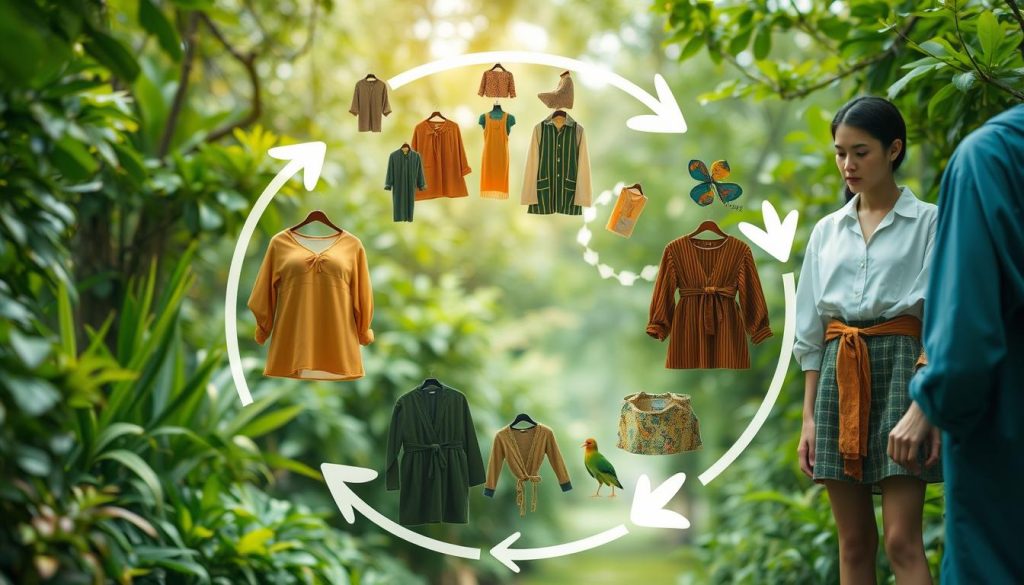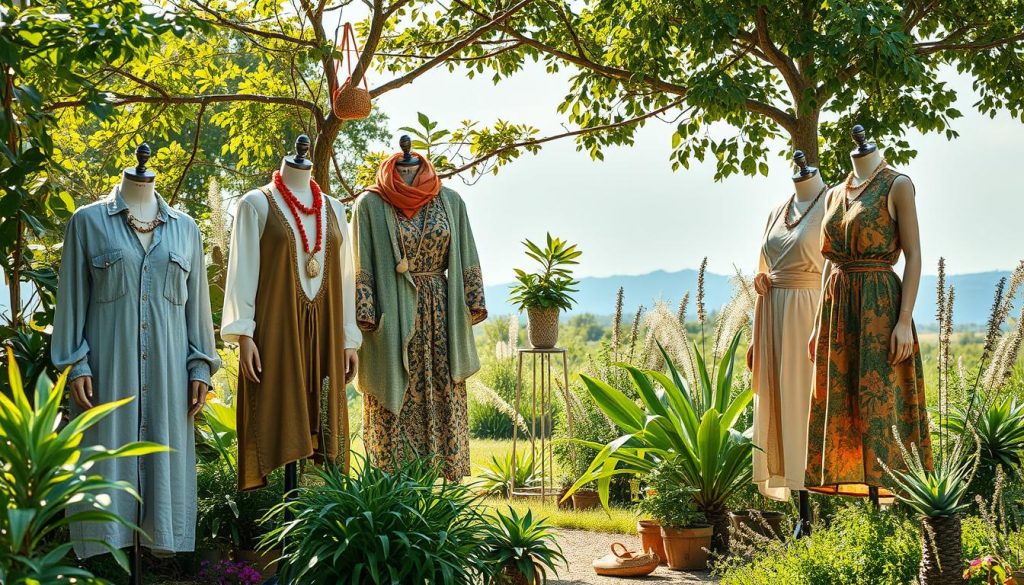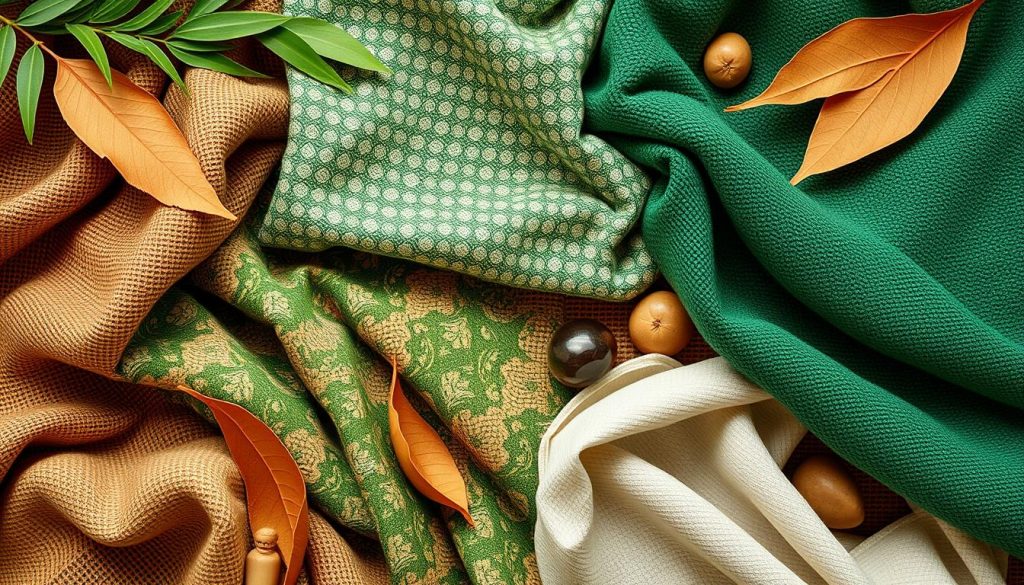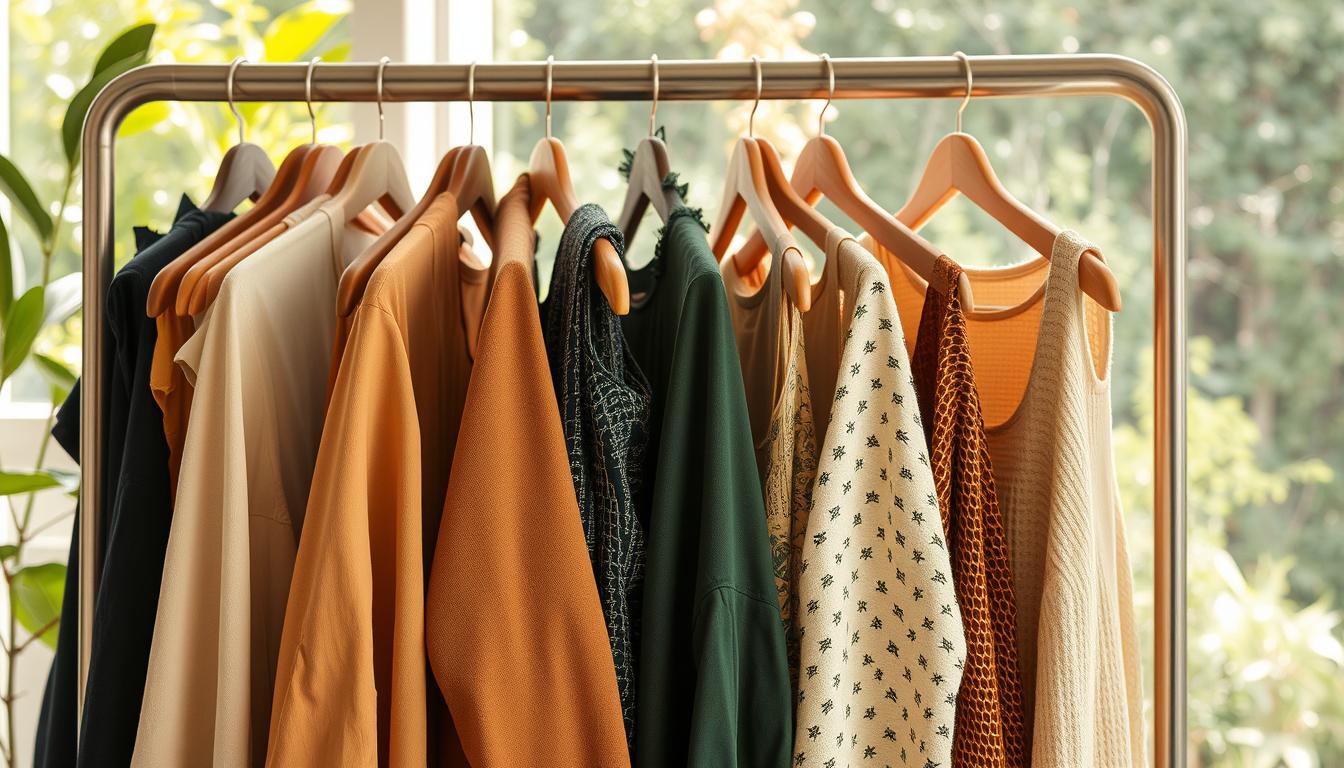I’m excited to explore sustainable fashion with you. We’ll learn how to look good while protecting our planet. Sustainable fashion is more than a trend; it’s changing how we see clothes.
In this guide, I’ll share tips on choosing ethical fashion. We’ll talk about the impact of our clothes and find eco-friendly brands. Let’s update our wardrobes and make a difference, one outfit at a time!
Understanding the Sustainable Fashion Movement
I’ve been diving into sustainable fashion, and it’s thrilling to see how it’s changing our view on clothes. Slow fashion, green fashion, and conscious clothing are more than just trends. They’re leading a big change in the fashion world.
The start of sustainable fashion dates back to the early 2000s. Back then, people started worrying about fast fashion’s harm to the environment. Now, it’s a worldwide movement that values quality over speed. It aims to make clothes that last longer and are better for our planet.
Green fashion is at the core of this movement. It’s about using materials and making clothes in ways that are good for the earth. As someone who shops, I’ve seen more people looking for clothes that are made with care and respect for the planet.
Let’s look at the main parts of the sustainable fashion movement:
| Aspect | Description | Impact |
|---|---|---|
| Slow Fashion | Focus on quality and longevity | Reduces waste and overconsumption |
| Green Fashion | Use of eco-friendly materials and processes | Lowers environmental impact |
| Conscious Clothing | Ethical production and fair labor practices | Improves worker conditions and livelihoods |
By following these principles, we can all help make fashion more eco-friendly. It’s about making choices that help both people and the planet.
The Environmental Impact of Fast Fashion

Fast fashion is harming our planet. I’ve seen its effects and it’s time to talk about it. Let’s look at the big problems and how we can fix them with circular fashion and sustainable textiles.
Water Pollution and Textile Waste
The fashion world pollutes a lot of water. Dyeing clothes alone uses 5 trillion liters of water each year. That’s enough to fill 2 million Olympic pools! This polluted water ends up in rivers, filled with harmful chemicals. It’s a clear sign we need better production methods.
Carbon Footprint of Fashion Industry
Fashion is a big carbon emitter. It’s responsible for 10% of global carbon emissions. That’s more than flights and ships combined. We must choose clothes wisely and support brands that use sustainable materials.
Microfiber Pollution in Oceans
Washing synthetic clothes releases tiny plastic fibers into our water. These microfibers are found in our oceans’ deepest parts. It’s a hidden problem hurting marine life. Using natural fibers is a step towards fixing this.
| Environmental Issue | Impact | Sustainable Solution |
|---|---|---|
| Water Pollution | 5 trillion liters used annually | Water-efficient dyeing techniques |
| Carbon Emissions | 10% of global emissions | Renewable energy in production |
| Microfiber Pollution | 35% of ocean microplastics | Use of natural, biodegradable fibers |
Circular fashion offers hope. It aims to make clothes last longer and recycle them. We need to change how we make, buy, and care for clothes. Together, we can make fashion more sustainable.
Key Principles of Eco-Friendly Clothing

Eco-friendly clothing is changing the fashion world. It’s not just about looking good. It’s about making choices that help people and the planet. Let’s look at the main ideas behind this movement.
Ethical Production and Fair Trade
Fair trade fashion is central to sustainable clothing. It makes sure workers get fair pay and work in safe places. Many eco-friendly brands are open about their supply chains. They work with local artists, helping communities and keeping traditional skills alive.
Use of Sustainable Materials
Sustainable textiles are crucial for reducing fashion’s harm to the environment. Organic cotton, hemp, and recycled fibers are favorites. They need less water and chemicals to make. Some brands are even making fabrics from things like pineapple leaves or recycled plastic.
| Material | Environmental Benefits | Durability |
|---|---|---|
| Organic Cotton | Pesticide-free, less water usage | High |
| Hemp | Requires minimal water, pesticide-free | Very High |
| Recycled Polyester | Reduces plastic waste, less energy intensive | Medium |
Longevity and Durability in Design
Eco-friendly clothing values quality over quantity. Clothes made to last mean less waste. I’ve seen a shift towards timeless styles that beat fast fashion trends. This way, we can build a sustainable wardrobe with fewer, better pieces.
By following these principles, we can help make fashion more sustainable. Whether it’s choosing fair trade, using sustainable materials, or buying durable clothes, every choice counts. Together, we can make a difference in the world of eco-friendly clothing.
Sustainable Fashion: Redefining Style with Consciousness
I’ve seen a big change in the fashion world. Now, conscious clothing is a major movement. It’s changing how we choose our style. Green fashion is leading the way, showing us that we can look good and feel good about our choices.
Ethical fashion brands are changing the game. They make stunning clothes that are both stylish and sustainable. Designers are using eco-friendly materials to create chic, eco-friendly garments.
The rise of sustainable fashion is bringing new ideas to the table. We’re seeing upcycled denim, plant-based leather, and recycled polyester. These new materials let us express our style while being kind to the planet.
| Traditional Fashion | Sustainable Fashion |
|---|---|
| Fast-changing trends | Timeless designs |
| Synthetic materials | Eco-friendly fabrics |
| Mass production | Small-batch manufacturing |
| Disposable clothing | Durable, long-lasting pieces |
Choosing conscious clothing has made me more connected to my clothes. Each piece has a story of ethical making and careful design. It’s amazing to see how green fashion is changing style, showing that we can have both beauty and sustainability.
Innovative Sustainable Textiles and Materials

The world of sustainable textiles is changing fast. I’ve seen new eco-friendly clothing that’s changing fashion. Let’s look at some key materials leading to a greener future.
Organic Cotton and Hemp
Organic cotton is a big deal for the environment. It’s grown without harmful chemicals. Hemp is also great, growing quickly and needing less water. Both are biodegradable, fitting well into the circular fashion model.
Recycled Polyester and Nylon
Turning plastic bottles into clothes is amazing. Recycled polyester and nylon cut down on waste and energy. They make clothes that are both durable and stylish.
Biodegradable Fabrics
Biodegradable fabrics are the next step in sustainable fashion. Materials like Tencel and PLA (from corn starch) break down easily. They’re soft, breathable, and leave no trace when disposed of right.
| Material | Benefits | Circular Fashion Impact |
|---|---|---|
| Organic Cotton | Pesticide-free, less water use | Biodegradable, renewable |
| Hemp | Fast-growing, durable | Low environmental impact |
| Recycled Polyester | Reduces plastic waste | Closes the loop on plastics |
| Biodegradable Fabrics | Natural decomposition | Zero waste at end-of-life |
These new materials are changing fashion. They’re not just good for the planet; they’re also stylish and comfortable. As consumers, we can support these sustainable textiles and help the circular fashion movement grow.
Building a Sustainable Wardrobe: Tips and Tricks
Creating a sustainable wardrobe is simpler than you might think. I’ve found some excellent ways to adopt slow fashion and make smart clothing choices. Let’s dive into how to build an ethical fashion collection that’s both stylish and eco-friendly.
First, take stock of what you already own. Often, I find hidden gems in my closet that I’d forgotten about. This helps me avoid buying too much and appreciate what I have.
When shopping, I focus on quality over quantity. Buying well-made pieces that last longer is key to slow fashion. I look for timeless designs that won’t go out of style quickly.
- Choose natural, sustainable fabrics like organic cotton or hemp
- Support ethical fashion brands with transparent supply chains
- Opt for versatile pieces that can be mixed and matched
- Consider second-hand or vintage items for unique finds
I’ve also adopted the capsule wardrobe concept. This means curating a small collection of versatile pieces that can be worn in many ways. It’s a smart way to reduce waste while still having lots of outfit options.
| Sustainable Wardrobe Essentials | Benefits |
|---|---|
| Organic cotton t-shirts | Breathable, versatile, eco-friendly |
| Hemp jeans | Durable, low water usage in production |
| Recycled polyester jacket | Reduces plastic waste, weather-resistant |
| Bamboo socks | Soft, naturally antimicrobial |
Remember, building a sustainable wardrobe is a journey. Start small and make smart choices. Over time, you’ll build a collection that shows your style and supports ethical fashion.
Circular Fashion: Closing the Loop in Clothing Production
Circular fashion is changing how we view clothes. It focuses on a closed-loop system where nothing is wasted. This approach is transforming sustainable fashion and responsible production.
Upcycling and Recycling in Fashion
Upcycling gives old clothes a new life. Designers turn discarded items into trendy pieces. Recycling breaks down materials to make new fabrics. These methods cut down waste and save resources, making fashion greener.
Rental and Resale Markets
Renting clothes is becoming more popular. It lets us enjoy different styles without buying too much. Resale platforms give old clothes a new home. These markets help clothes last longer, reducing environmental harm.
Designing for Disassembly
Smart design is crucial in circular fashion. Clothes made for easy disassembly can be recycled better. This design considers a garment’s whole life, from making to disposal. It’s a big step towards responsible production.
By adopting these methods, we’re moving towards a greener fashion industry. It’s thrilling to see how circular fashion is changing our relationship with clothes. Now, style and sustainability go together.
Ethical Fashion Brands Leading the Way
I’ve been diving into sustainable fashion and found some amazing brands. They’re not just talking about being green; they’re actually doing it. These companies use eco-friendly materials and follow ethical practices.
Patagonia is a leader in sustainable fashion. They use recycled materials and encourage customers to fix their clothes instead of buying new ones. They also make sure workers are paid fairly and work in safe places.
Eileen Fisher is another brand I’m excited about. They create clothes that last, reducing the need for new purchases. They use organic fabrics and have a program to take back used clothes for recycling or resale.
Reformation shows that sustainable fashion can be stylish. They use materials like Tencel and deadstock to make trendy clothes. They’re open about their environmental impact, setting a high standard in the industry.
| Brand | Key Sustainable Practices | Signature Materials |
|---|---|---|
| Patagonia | Repair program, Fair trade | Recycled polyester, Organic cotton |
| Eileen Fisher | Take-back program, Timeless design | Organic linen, Recycled cashmere |
| Reformation | Carbon neutrality, Local production | Tencel, Deadstock fabrics |
These brands prove that ethical fashion is more than a trend. It’s the future of style. By choosing to support them, we look good and do good for our planet and people.
The Role of Consumers in Promoting Green Fashion
We all play a role in making fashion more eco-friendly. Our choices can change the industry. By choosing green fashion, we help make the world more environmentally conscious.
Mindful Shopping Habits
When I shop, I think about the impact. I ask if I really need something and if it will last. Buying quality items that I’ll wear often is better than fast fashion.
I look for clothes made from sustainable materials. This includes organic cotton or recycled fabrics.
Caring for Clothes to Extend Lifespan
Good care makes clothes last longer. I wash them less and use cold water. Hanging clothes to dry saves energy and keeps them looking good.
When clothes tear, I mend them instead of throwing them away. These small steps help reduce waste and support sustainable fashion.
Supporting Sustainable Brands
I try to support brands that focus on green fashion. Many companies now use ethical production and eco-friendly materials. By choosing these brands, I’m voting for a sustainable fashion industry.
It’s exciting to see how my choices can help shape a greener future for fashion.

